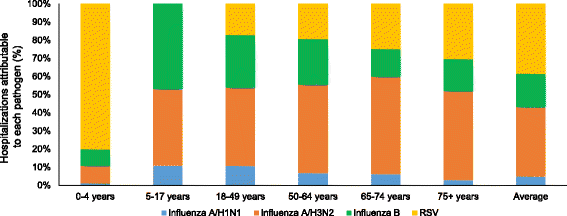Estimates of hospitalization attributable to influenza and RSV in the US during 1997-2009, by age and risk status
- PMID: 28320361
- PMCID: PMC5359836
- DOI: 10.1186/s12889-017-4177-z
Estimates of hospitalization attributable to influenza and RSV in the US during 1997-2009, by age and risk status
Abstract
Background: Estimates of influenza and respiratory syncytial virus (RSV) burden must be periodically updated to inform public health strategies. We estimated seasonal influenza- and RSV-attributable hospitalizations in the US from 1997 to 2009 according to age and risk status (NCT01599390).
Methods: Multiple linear regression modelling was used to attribute hospitalizations to influenza or RSV using virological surveillance and hospitalization data. Hospitalization data were obtained from the US Nationwide Inpatient Sample and virology data were obtained from FluView (Centers for Disease Control and Prevention). Outcomes included any mention of ICD-coded respiratory disease and cardiorespiratory disease diagnoses. We also explored a broader definition of respiratory disease that included mention of relevant respiratory sign/symptoms and viral infection ("respiratory broad").
Results: Applying the respiratory broad outcome, our model attributed ~300,000 and ~200,000 hospitalizations to influenza and RSV, respectively. Influenza A/H3N2 was the predominant cause of influenza-related hospitalizations in most seasons, except in three seasons when influenza B was dominant; likewise, A/H3N2 caused most influenza-related hospitalizations in all age segments, except in children <18 years where the relative contribution of A/H3N2 and B was similar. Most influenza A- and B-related hospitalizations occurred in seniors while approximately one half and one third of all RSV-related events occurred in children 0-4 years and seniors 65+ years, respectively. High-risk status was associated with higher risk of both influenza- and RSV-attributable hospitalizations in adults, but not in children.
Conclusions: Our study assessed the burden of influenza and RSV, information that is important for both cost effectiveness studies and for prioritization of the development of antivirals and vaccines. For seniors, we found that the burdens of influenza and RSV were both substantial. Among children <18 years, about half of all influenza hospitalizations were due to influenza B, most occurring in children without noted risk conditions. RSV hospitalizations among children were confined to those 0-4 years. Our study also demonstrated the importance of the outcome used to estimate hospitalization burden. Our findings highlight the burden of influenza among children regardless of risk status and underscore the prevalence of RSV infections among both young children and older adults.
Keywords: A/H3N2; Influenza; Mortality; Respiratory broad; Respiratory syncytial virus.
Figures
References
MeSH terms
Associated data
LinkOut - more resources
Full Text Sources
Other Literature Sources
Medical



